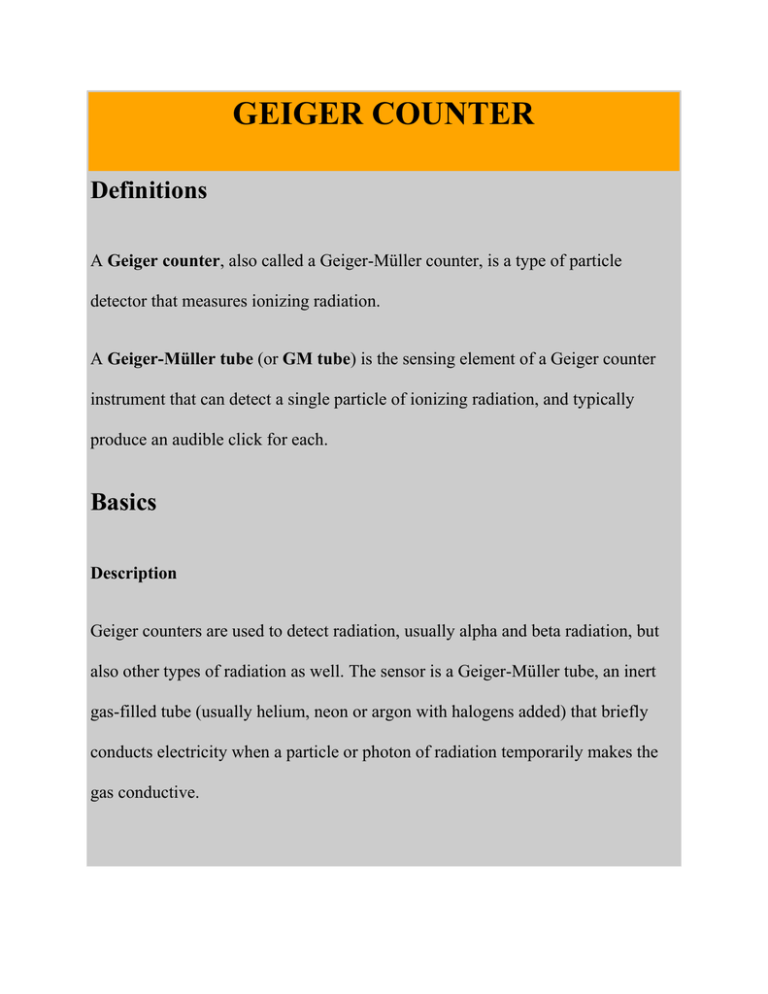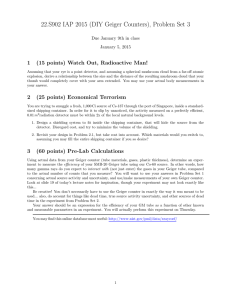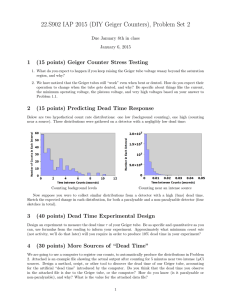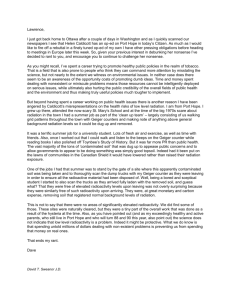GEIGER COUNTER
advertisement

GEIGER COUNTER Definitions A Geiger counter, also called a Geiger-Müller counter, is a type of particle detector that measures ionizing radiation. A Geiger-Müller tube (or GM tube) is the sensing element of a Geiger counter instrument that can detect a single particle of ionizing radiation, and typically produce an audible click for each. Basics Description Geiger counters are used to detect radiation, usually alpha and beta radiation, but also other types of radiation as well. The sensor is a Geiger-Müller tube, an inert gas-filled tube (usually helium, neon or argon with halogens added) that briefly conducts electricity when a particle or photon of radiation temporarily makes the gas conductive. The tube amplifies this conduction by a cascade effect and outputs a current pulse, which is then often displayed by a needle or lamp and/or audible clicks. Modern instruments can report radioactivity over several orders of magnitude. Some Geiger counters can also be used to detect gamma radiation, though sensitivity can be lower for high energy gamma radiation than with certain other types of detector, due to the fact that the density of the gas in the device is usually low, allowing most high energy gamma photons to pass through undetected (lower energy photons are easier to detect, and are better absorbed by the detector. Examples of this are the X-ray Pancake Geiger Tube). A better device for detecting gamma rays is a sodium iodide scintillation counter. Good alpha and beta scintillation counters also exist, but Geiger detectors are still favored as general purpose alpha/beta/gamma portable contamination and dose rate instruments, due to their low cost and robustness. A variation of the Geiger tube is used to measure neutrons, where the gas used is Boron Trifluoride and a plastic moderator is used to slow the neutrons. This creates a gamma ray inside the detector and thus neutrons can be counted. Types and applications The Geiger-Müller tube is one form of a class of radiation detectors called gaseous detectors or simply gas detectors. Although useful, cheap and robust, a counter using a GM tube can only detect the presence and intensity of radiation. Gas detectors with the ability to both detect radiation and determine particle energy levels (due to their construction, test gas, and associated electronics) are called proportional counters. Some proportional counters can detect the position and or angle of the incident radiation as well. Other devices detecting radiation include: ionization chamber, dosimeters, photomultiplier, semiconductor detectors and variants including CCDs, micro channel plates, scintillation counters, solid-state track detectors, cloud chambers, bubble chambers, spark chambers, neutron detectors and micro calorimeters. The Geiger-Müller counter has applications in the fields of nuclear physics, geophysics (mining) and medical therapy with isotopes and x-rays. Some of the proportional counters have many internal wires and electrodes and are called multiwire proportional counters or simply MWPCs. Radiation detectors have also been used extensively in nuclear physics, medicine, particle physics, astronomy and in industry. The Geiger counter is sometimes used as a hardware random number generator. History Hans Geiger developed a device (that would later be called the "Geiger counter") in 1908 together with Ernest Rutherford. This counter was only capable of detecting alpha particles. In 1928, Geiger and Walther Müller (a PhD student of Geiger) improved the counter so that it could detect all kinds of ionizing radiation. The current version of the "Geiger counter" is called the halogen counter. It was invented in 1947 by Sidney H. Liebson (Phys. Rev. 72, 602–608 (1947)). It has superseded the earlier Geiger counter because of its much longer life. The devices also used a lower operating voltage. Geiger-Müller Tube A Geiger-Müller tube (or GM tube) is the sensing element of a Geiger counter instrument that can detect a single particle of ionizing radiation, and typically produce an audible click for each. It was named for Hans Geiger who invented the device in 1908, and Walther Müller who collaborated with Geiger in developing it further in 1928. It is a type of gaseous ionization detector with an operating voltage in the Geiger plateau. It consists of a tube filled with an inert gas such as helium, neon or argon, in some cases in a Penning mixture, and an organic vapor or a halogen. The tube contains electrodes, between which there is an electrical voltage of several hundred volts, but no current flowing. The walls of the tube are either metal or the inside coated with metal or graphite to form the cathode while the anode is a wire passing up the center of the tube. When ionizing radiation passes through the tube, it ionizes some of the gas molecules, creating positively charged ions, and electrons. The strong electric field created by the tube's electrodes accelerates the ions towards the cathode and the electrons towards the anode. The ion pairs gain sufficient energy to ionise further gas molecules through collisions on the way, creating an avalanche of charged particles. This results in a short, intense pulse of current which passes (or cascades) from the negative electrode to the positive electrode and is measured or counted. To prevent the current from flowing continuously there are several techniques to stop, or quench the discharge. Quenching is important because a single particle entering the tube is counted by a single discharge, and so it will be unable to detect another particle until the discharge has been stopped, and because the tube is damaged by prolonged discharges. External quenching uses external electronics to remove the high voltage between the electrodes. Self-quenching or internal-quenching tubes stop the discharge without external assistance, and contain a small amount of a polyatomic organic vapor such as butane or ethanol; or alternatively a halogen such as bromine or chlorine. Ions will collide with quench gas molecules, and give up energy to them by causing them to dissociate. The halogen tubes were invented by Sidney H. Liebson in 1947, and are now the most common form, since the discharge mechanism takes advantage of the metastable state of the inert gas atom to ionize the halogen molecule and produces a more efficient discharge which permits it to operate at much lower voltages, typically 400–600 volts instead of 900–1200 volts. It also has a longer life because the halogen ions can recombine whilst the organic vapor cannot and is gradually destroyed by the discharge process (giving the latter a life of around 108 events). Most detectors include an audio amplifier that produces an audible click on discharge. The number of pulses per second measures the intensity of the radiation field. Some Geiger counters display an exposure rate (e.g. mR·h), but this does not relate easily to a dose rate as the instrument does not discriminate between radiation at different energy levels. The usual form of tube is an end-window tube. This type is so-named because the tube has a window at one end through which ionizing radiation can easily penetrate. The other end normally has the electrical connectors. There are two types of end-window tubes: the glass-mantle type and the mica window type. The glass window type will not detect alpha radiation since it is unable to penetrate the glass, but is usually cheaper and will usually detect beta radiation and X-rays. The mica window type will detect alpha radiation but is more fragile. Most tubes will detect gamma radiation, and usually beta radiation above about 2.5 MeV. Geiger-Müller tubes will not normally detect neutrons since these do not ionise the gas. However, neutron-sensitive tubes can be produced which either have the inside of the tube coated with boron or contain boron trifluoride or helium-3 gas. The neutrons interact with the boron nuclei, producing alpha particles or with the helium-3 nuclei producing hydrogen and tritium ions and electrons. These charged particles then trigger the normal avalanche process. Source: http://www.juliantrubin.com/encyclopedia/electronics/geiger_counter.html





